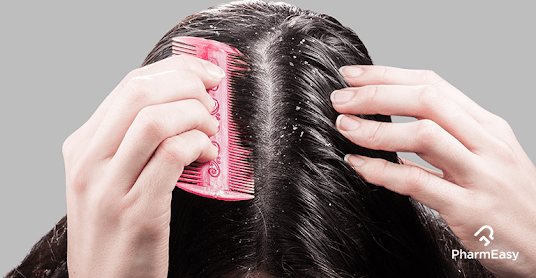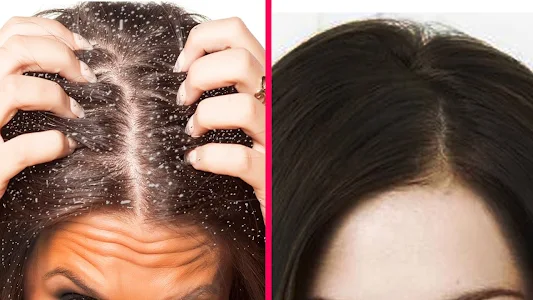How to Get Rid of Dandruff Naturally: Treat Dandruff Naturally With These 3 Amazingly Effective Remedies
Signs and Symptoms of Dandruff
The big tip-off that an individual may have dandruff is the telltale patches of white flakes on the scalp, made up of dead skin, that come loose in your hair. According to the Merck Manual, other signs include:
- At times, the scalp can be itchy
- Greasy or dry scales on the scalp
- Yellowish to reddish scaly raised bumps along the hairline (in severe cases)
Causes and Risk Factors of Dandruff
Dandruff can happen for a number of reasons:
Seborrheic Dermatitis: If you have a particularly bad case of dandruff, it’s likely a mild case of seborrheic dermatitis (SD), according to the American Osteopathic College of Dermatology.
SD is a chronic form of eczema that impacts areas of the body that secrete the most sebum, or oil, notes the National Eczema Association.
People with oily skin are often more prone to dandruff. The reason:
Still, it's important to note that while M. globosa has long been thought to be the main risk factor for dandruff, a causal relationship has yet to be firmly established, noted a July 2019 report in the journal Experimental Dermatology.
READ MORE: 5 Easy Recipes of Onion Juice for Hair Growth At Home
Dry Skin: If cold winter air dries out your skin all over, including your scalp, then dry skin may be the cause of your dandruff. When dry skin causes dandruff, the flakes are usually smaller and less oily than the flakes caused by SD, notes PIH Health.
(In addition, cold and dry climates can also worsen SD, according to the Cleveland Clinic.)
Almost anyone can have dandruff, but certain factors can make you more susceptible, including:
Age: Dandruff often begins at puberty and peaks around age 20, becoming far less prevalent among folks over 50 years old, according to a review published in December 2015 in the Journal of Clinical and Investigative Dermatology.
Gender: Androgen hormones, such as testosterone, stimulate activity in the sebaceous glands. More oil means an increased chance of an inflammatory reaction and dandruff. Men are more frequently affected by dandruff than women.
ALSO READ: 7 Tips To Grow Your Hair Naturally
Weakened Immune: System SD is more prevalent in individuals who’ve undergone an organ transplant and those with HIV or AIDS, hepatitis C, or alcoholic pancreatitis. For example, 30 percent to 83 percent of those with HIV report SD.
History of Other Skin Disorders: Having had eczema, rosacea, psoriasis, or acne can trigger or worsen seborrheic dermatitis.
Oily Skin: If you have naturally oily skin, you’re at an elevated risk for seborrheic dermatitis.
How Is Dandruff Diagnosed?
A dermatologist can usually diagnose dandruff simply by looking at your scalp. If your dandruff does not respond to treatment, your healthcare provider may opt to perform a skin biopsy in order to rule out other possible issues.
How to Get Rid of Dandruff Naturally
The greatest enemy of healthy hair is dandruff. This is a problem that worries many women, and experts reckon that one in every three suffers from it.
There are a number of home remedies for dandruff that can help you shake the flake, but today we present you the three most efficient remedies that will help you to get rid of dandruff.
1. Lemon Juice Remedy
Massage your scalp using two tablespoons of lemon juice and leave it for a few minutes. Then wash your hair with some lemon juice and water solution -- add a tablespoon of lemon juice in 7 oz (200 milliliters) of water and wash the hair with this mixture.
If you have long hair, increase the amount of water and lemon juice, of course, in the same proportion. Repeat the procedure as often as you can, until the itchy feeling and dandruff completely disappear. Lemon juice cleans the skin on your head, and your hair will also smell nice.
2. Bay Leaf Tea
Boil a liter of water (4 cups) and add a few bay leaves. After the tea cools for a while, strain it and wash your hair. Wrap it in a towel and leave it for an hour, then rinse with warm water.
3. Apple Cider Vinegar
It balances the pH of the skin on your head, so it is an amazingly efficient dandruff remedy, which should be in no way underestimated. After washing your hair, rinse it with water and apple cider vinegar solution (4 cups / 1 liter of water-100 milliliters / 3.5 oz apple cider vinegar). Do not worry about the smell, it will evaporate completely after your hair dries. (How to Make Natural Apple Cider Vinegar: Make Organic Apple Cider Vinegar at Home)












.jpg)
